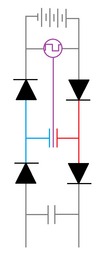
There's a voltage multiplier circuit that I've been thinking about making, but don't really have any of the things I'd need to test it, but here's a crude drawing of what it'd look like. There's a battery that powers a high frequency square wave signal generator, which is connected to one plate of a 3-plate capacitor. The other 2 plates are connected to the positive and negative of the battery. I didn't really show it in the drawing, but it should be rolled so the capacitance between positive and negative, negative and AC, and AC and positive, should all be equal. A change in capacitance over time produces a change in voltage in a capacitor, the faster and greater the change, the greater the change in voltage. And if I'm right, it works better with a dense, high-K dielectric, and the AC signal counts as a change in capacitance, switching between being an extension of the other capacitors.
Again, if I'm right, the output amperage would be nearly the same as the input, aside from losses, but the output voltage would be significantly higher.